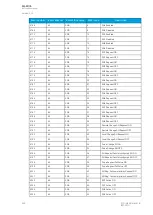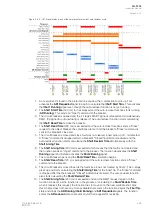
Only a minority of overhead line faults are of the permanent type which require maintenance or repair
in the actual fault location. This type of fault include lightning striking the line, a tree branch touching
the line, an arc caused by animals, and a short-circuit caused by some other object touching the line. If
the fault is permanent (e.g. a broken insulator or a fallen tree leaning on the overhead line), the auto-
recloser cannot clear the fault and the faulty feeder is locked and prevented from closing until the
cause of the fault is repaired in the actual fault location. Also, when a fault cannot be cleared by auto-
reclosing the line, any close-distance short-circuits should avoid initiating the auto-recloser because
that would only cause unnecessary stress for the lines and the circuit breakers. Similar situations also
rise in mixed networks since cable network faults cannot be cleared with the auto-recloser. The
function must therefore be aware of the fault location before applying the auto-recloser to the faulty
line.
Auto-recloser as application
The main principle of the auto-recloser is to de-energize the faulty line and the fault location so
the cause of the fault can drop out from the line. When the line is energized and an object either
touches the line or drops onto the line, the current starts to flow through the object either to the ground
or between the phases. This causes the surrounding air to heat and ionize, and it starts to operate as a
conductor between the energized phase(s) and the ground causing an arc to ignite.
When the breaker is opened (either by an auto-recloser command or by a protection function), the
voltage in the line goes to zero. This extinguishes the arc and lets the fault-causing object to drop from
the line, thus clearing the cause of the fault. Auto-reclosing closes the breaker after a set time (called
'dead time' during which the line is not energized) and the supply is restored to the line. If the fault is not
cleared by the first auto-recloser cycle (called 'shot'), more shots can be applied to the line.
Alternatively, the function can be set to initiate the final trip, locking the feeder closing. The decision
between a single-shot and a multi-shot auto-recloser depends on the following: protection type,
switchgear, circuit breaker, stability requirements, network type, consumer loads as well as local utility
knowledge and network practices.
The user can select whether there is a set time delay (called 'arcing time') between shots to burn the
fault-causing object from the line, or whether normal protection operating times are applied. When a
fault is not present when the breaker is closed but reappears soons after (called 'discrimination time'
and 'reclaim time'), the auto-recloser function can either arm another shot or give the final trip
command and the feeder becomes locked. The user can select the preferred method in the function's
settings.
It is difficult to define a typical auto-recloser scheme because the above-mentioned parameters (and
thus the main parameters of a scheme) vary greatly in distribution and transmission networks. This is
why there are no universally applicable answers from the number of shots and the duration of the dead
times to which protection functions should trigger the auto-recloser.
The minimum times for the "Dead time" setting is mostly dependent on the voltage level of the
protected network: the air needs enough time to de-ionize before the circuit breaker is opened. For
medium-voltage networks (20...75 kV) a 200 ms dead time should be sufficient. High-voltage networks
require a longer dead time: a 110 kV network needs 300 ms and a 400 kV network needs 400...500
ms. This minimum time is not, however, less straightforward than this as it is affected by other
parameters as well (such as conductor spacing, wind speed, fault type, fault duration, etc.). The main
purpose of the "Dead time" setting is to give enough time for the air surrounding the fault location to
return to its isolating state before the line is re-energized and therefore prevent the arc from reignite
due to the heated and ionized air. The circuit breaker's open-close-open cycle capacity is another
restricting factor for the minimum "Dead time" setting in low-voltage networks. In high-voltage
networks, the time de-ionizing requires puts additional limitations on the minimum "Dead time" setting.
The user can build different schemes for evolving faults (such as transient earth faults that become
multi-phase short-circuits or overcurrent faults) by changing the priorities and behaviors requests have.
The auto-recloser function has five (5) independent priority requests for reclosing: REQ1 has the
highest priority and REQ5 the lowest. The function also has one (1) critical request which halts the
reclosing in any position when the request is received.
A
AQ
Q-F205
-F205
Instruction manual
Version: 2.04
© Arcteq Relays Ltd
IM00013
261
Summary of Contents for AQ F205
Page 1: ...AQ F205 Feeder protection IED Instruction manual ...
Page 2: ......
















































